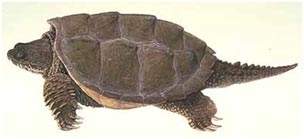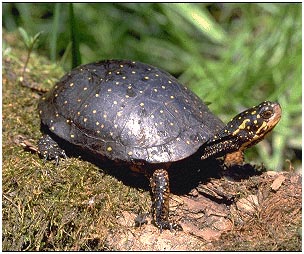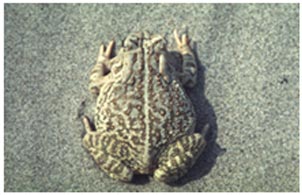SNAPPING TURTLE (Chelydra serpentina)

While water sampling, snapping turtle nests were found regularly on the side of roads. The roads had soft shoulders and a gravely, sandy structure to them and were always somewhat close to a body of water. Note: Many nests were destroyed by other creatures; however a few hatchlings were identified in the shallows of Beaver Creek. (Off Bertie St.)
Features
The Snapping Turtle is Canada’s largest freshwater turtle, reaching an average length of 20-36 cm and a weight of 4.5-16.0 kg. Snapping Turtles have large black, olive or brown shells typically covered in algae. Their tails, which can be longer than their body, “dinosaur-like” triangular crests along their length. Hatchlings are about the size of a loonie and are smaller and darker than adults, with pronounced ridges along the length of their shell.
Habitat
Snapping Turtles spend most of their lives in water. They prefer shallow waters so they can hide under the soft mud and leaf litter, with only their noses exposed to the surface to breathe. During the nesting season, from early to mid summer, females travel overland in search of a suitable nesting site, usually gravely or sandy areas along streams. Snapping Turtles often take advantage of man-made structures for nest sites, including roads (especially gravel shoulders), dams and aggregate pits.
Range
The Snapping Turtle’s range extends from Ecuador to Canada. In Canada this turtle can be found from
Saskatchewan to Nova Scotia. It is primarily limited to the southern part of Ontario. The Snapping Turtle’s range is contracting.
Threats
It takes 15 to 20 years for a Snapping Turtle to reach maturity. As a result, adult mortality greatly affects the species’ survival. During the summer, many turtles cross roads in search of mates, food and nest sites. This is risky for turtles as they are to slow to get out of the way of moving vehicles. Snapping Turtles are also sometimes intentionally persecuted. Eggs in nests around urban and agricultural areas are subject to predators such as Raccoons and Striped Skunks surrounding.
Protection
The Snapping Turtle is a special concern species under Ontario’s Endangered Species Act, 2007. A management plan will be prepared. The Snapping Turtle has also been assessed nationally as
A special concern species by the federal Committee on the Status of Endangered Wildlife in Canada
(COSEWIC). Status: special concern provincially and designated special concern federally
SPOTED TURTLE (Clemmys guttata)
Last summer a group of volunteers and coop students from FOFEC, found two spotted turtles in Beaver Creek. The MNR (Ministry of Natural Resources) was called, and shortly afterwards came to Fort Erie to verify the finding directly. It was determined that the female was approximately 50 years of age, while the male was approximately 30 years of age. The age of the turtles is significant because they do not reach sexually maturity till they are older. Since the two are older they are both sexually mature, possibly making them a mating pair.
The FOFEC members along with the MNR had placed transponders on each of the spotted turtles, this way each turtle can be monitored regularly.
This summer while conducting water sampling the two spotted turtles were identified again at the same location as last summer. This is excellent news, knowing that they are both alive and still together.
Features
The Spotted Turtle (Clemmys guttata) is named for the distinctive bright yellow spots on its black upper shell or carapace. This relatively small turtle prefers ponds, marshes and bogs with an abundant supply of aquatic vegetation. Shortly after emerging from hibernation burrows in spring, adults congregate at favoured ponds to mate. Females lay eggs in soil and leaf litter in wooded areas close to wetlands. Turtles remain active until the fall when they again form groups and hibernate underground.
Status
Endangered Provincially and Nationally
Range
The Spotted Turtle occurs in eastern North America, from Maine and Ontario south to Florida, west to Michigan. In Ontario, it is widespread but much localized in southern Ontario. It is known from about 75 locations in Ontario.
Threats
The Spotted Turtle is vulnerable to habitat alteration by humans, nest predation by raccoons, and pollution. As it produces small clutches of eggs which have low hatching success, the ability of Spotted Turtle populations to recover from declines is limited, and very slow. They are subject to illegal collection for the pet trade, and are especially susceptible when they congregate in spring and fall.
Protection
The Spotted Turtle is listed as endangered under the provincial Endangered Species Act, 2007. The Act prohibits the harming, collecting, possessing, trading or killing of this species. Spotted Turtles are protected under Ontario's Fish and Wildlife Conservation Act. About one-third of Ontario's Spotted Turtle populations are on public lands, where they are afforded protection, as in national or provincial parks.
FOWLERS TOAD (Anaxyrus fowleri)
 There were times throughout the course of the summer when hiking different areas of the surrounding area was useful to gain additional knowledge of various habitats. Yvonne Hopkins, a member of the FOFEC organization had mentioned that the Fowlers Toad had previously been spotted on Waverly Beach. As a group, we had decided to walk the beach looking for signs of the Fowlers Toad. During our hike a Fowlers Toad was found beneath the sand in an area which was cover by shade. The toad was observed and then released back into its original location. We emailed pictures to the MNR to verify our findings. There were times throughout the course of the summer when hiking different areas of the surrounding area was useful to gain additional knowledge of various habitats. Yvonne Hopkins, a member of the FOFEC organization had mentioned that the Fowlers Toad had previously been spotted on Waverly Beach. As a group, we had decided to walk the beach looking for signs of the Fowlers Toad. During our hike a Fowlers Toad was found beneath the sand in an area which was cover by shade. The toad was observed and then released back into its original location. We emailed pictures to the MNR to verify our findings.
Features
Fowler's Toad is a medium-sized toad which lives on sandy beaches and breeds in marshy shallows of lakes or permanent ponds. In Ontario, individuals are gray with a few dark blotches; elsewhere, the toads are brown.
Status
Threatened Provincially and Nationally
Range
Fowler's Toad is widespread in eastern North America, ranging from the Gulf Coast north to the Great Lakes. In Ontario, it lives along the northern shore of Lake Erie where biologists estimate there are about 1,200 individuals.
Threats
Fowler's Toad reaches the northern limits of its range in southern Ontario and, consequently, its numbers here are low. Historically, it was reported on sandy beaches along the whole of northern Lake Erie. Its numbers fluctuate naturally, but the consensus is that it has declined in Ontario and disappeared from some sites. Current threats to the Ontario population are beach erosion from winter storms, habitat alteration by humans, and pollution caused by the presence of herbicides and insecticides in runoff from agricultural lands. Fowler's Toads do occasionally interbreed with American Toads (Bufo americanus), but this is not considered a threat to the population.
Protection
Under Ontario's Endangered Species Act 2007, the Fowler's Toad is protected from any actions (i.e. killing, harassing, trading, collecting, etc.) that may cause further harm to this species. Fowler's Toad occurs in protected areas such as Point Pelee National Park and in provincial parks at Long Point, Turkey Point and Rondeau. It is also protected under Ontario's Fish and Wildlife Conservation Act.
|